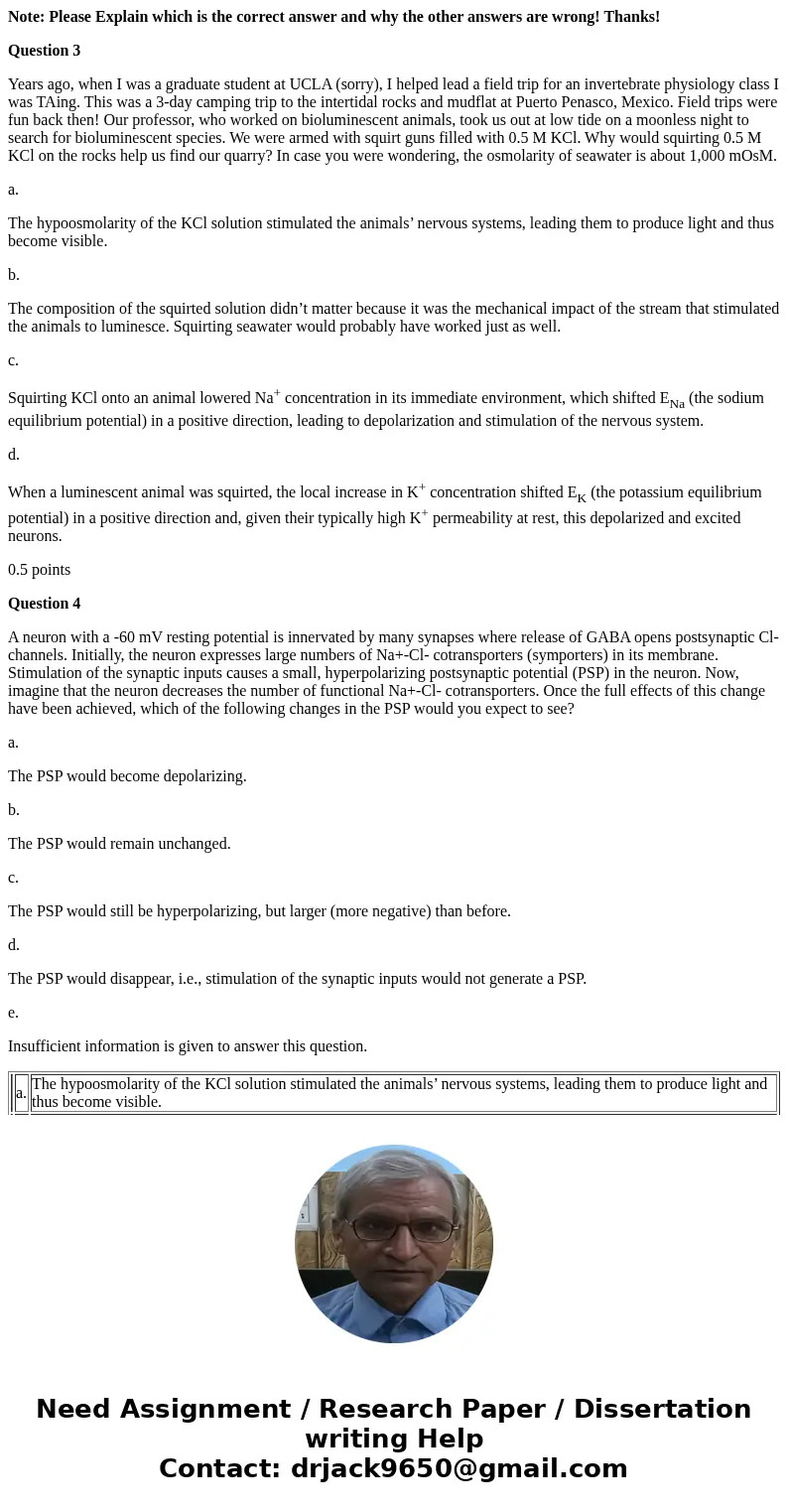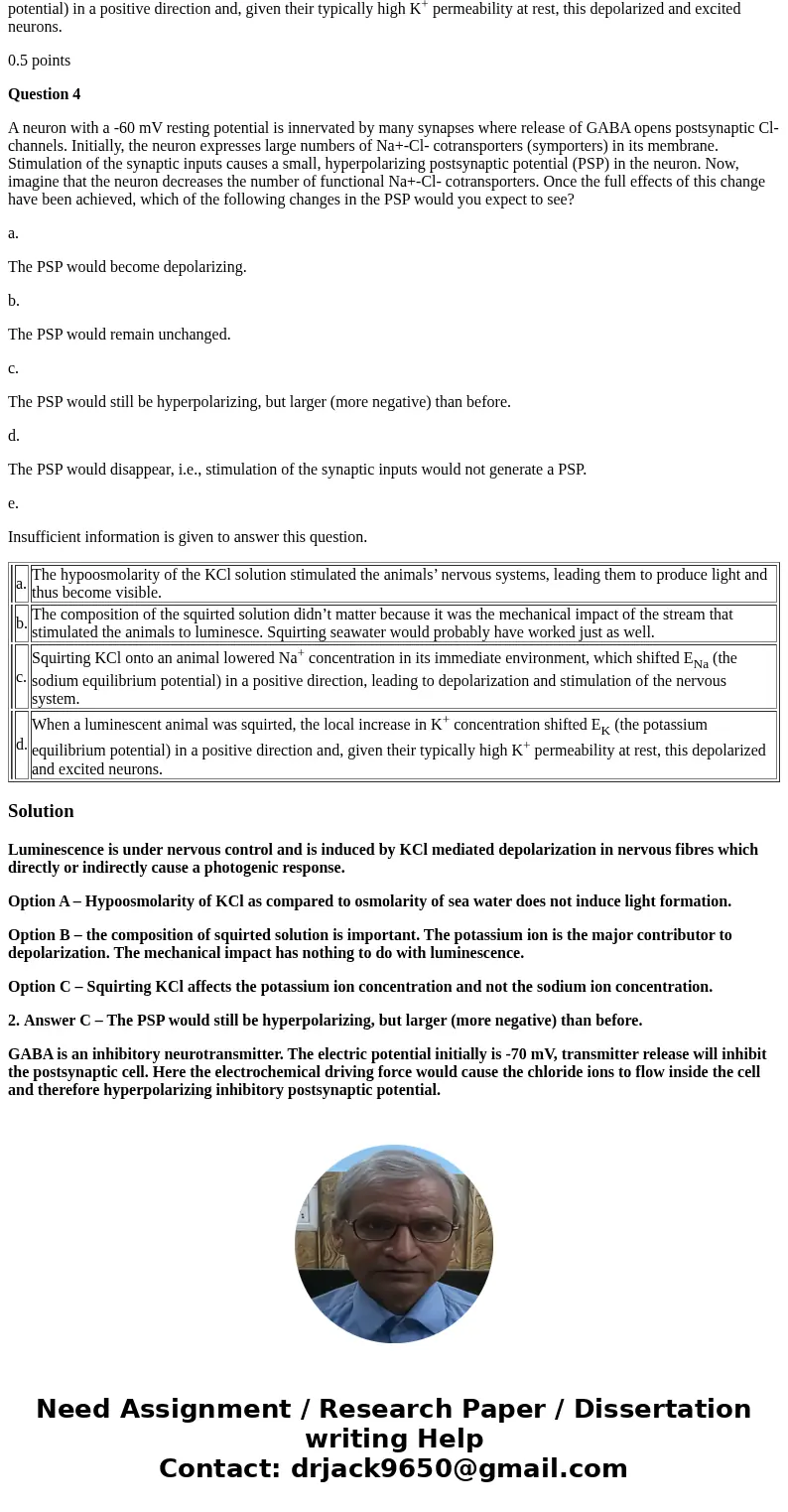Note Please Explain which is the correct answer and why the
Note: Please Explain which is the correct answer and why the other answers are wrong! Thanks!
Question 3
Years ago, when I was a graduate student at UCLA (sorry), I helped lead a field trip for an invertebrate physiology class I was TAing. This was a 3-day camping trip to the intertidal rocks and mudflat at Puerto Penasco, Mexico. Field trips were fun back then! Our professor, who worked on bioluminescent animals, took us out at low tide on a moonless night to search for bioluminescent species. We were armed with squirt guns filled with 0.5 M KCl. Why would squirting 0.5 M KCl on the rocks help us find our quarry? In case you were wondering, the osmolarity of seawater is about 1,000 mOsM.
a.
The hypoosmolarity of the KCl solution stimulated the animals’ nervous systems, leading them to produce light and thus become visible.
b.
The composition of the squirted solution didn’t matter because it was the mechanical impact of the stream that stimulated the animals to luminesce. Squirting seawater would probably have worked just as well.
c.
Squirting KCl onto an animal lowered Na+ concentration in its immediate environment, which shifted ENa (the sodium equilibrium potential) in a positive direction, leading to depolarization and stimulation of the nervous system.
d.
When a luminescent animal was squirted, the local increase in K+ concentration shifted EK (the potassium equilibrium potential) in a positive direction and, given their typically high K+ permeability at rest, this depolarized and excited neurons.
0.5 points
Question 4
A neuron with a -60 mV resting potential is innervated by many synapses where release of GABA opens postsynaptic Cl- channels. Initially, the neuron expresses large numbers of Na+-Cl- cotransporters (symporters) in its membrane. Stimulation of the synaptic inputs causes a small, hyperpolarizing postsynaptic potential (PSP) in the neuron. Now, imagine that the neuron decreases the number of functional Na+-Cl- cotransporters. Once the full effects of this change have been achieved, which of the following changes in the PSP would you expect to see?
a.
The PSP would become depolarizing.
b.
The PSP would remain unchanged.
c.
The PSP would still be hyperpolarizing, but larger (more negative) than before.
d.
The PSP would disappear, i.e., stimulation of the synaptic inputs would not generate a PSP.
e.
Insufficient information is given to answer this question.
| a. | The hypoosmolarity of the KCl solution stimulated the animals’ nervous systems, leading them to produce light and thus become visible. | |
| b. | The composition of the squirted solution didn’t matter because it was the mechanical impact of the stream that stimulated the animals to luminesce. Squirting seawater would probably have worked just as well. | |
| c. | Squirting KCl onto an animal lowered Na+ concentration in its immediate environment, which shifted ENa (the sodium equilibrium potential) in a positive direction, leading to depolarization and stimulation of the nervous system. | |
| d. | When a luminescent animal was squirted, the local increase in K+ concentration shifted EK (the potassium equilibrium potential) in a positive direction and, given their typically high K+ permeability at rest, this depolarized and excited neurons. |
Solution
Luminescence is under nervous control and is induced by KCl mediated depolarization in nervous fibres which directly or indirectly cause a photogenic response.
Option A – Hypoosmolarity of KCl as compared to osmolarity of sea water does not induce light formation.
Option B – the composition of squirted solution is important. The potassium ion is the major contributor to depolarization. The mechanical impact has nothing to do with luminescence.
Option C – Squirting KCl affects the potassium ion concentration and not the sodium ion concentration.
2. Answer C – The PSP would still be hyperpolarizing, but larger (more negative) than before.
GABA is an inhibitory neurotransmitter. The electric potential initially is -70 mV, transmitter release will inhibit the postsynaptic cell. Here the electrochemical driving force would cause the chloride ions to flow inside the cell and therefore hyperpolarizing inhibitory postsynaptic potential.


 Homework Sourse
Homework Sourse